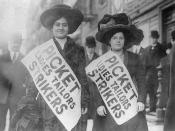In The Oppressing Hand of Avarice Would Enslave Us, Thomas Dublin says that the life and sense of community of the women mill operatives was crucial for their ability to protest wage cuts and long work days. This sense of community among the women was nurtured by the structure of mill life. The women lived and worked together in close conditions. They trained newcomers and covered for one another, when necessary. This cohesion amongst them provided the basis and the strength for their protests. It was helped by their sense of freedom as ?freemen's daughters.? The community was the most important factor for determining the response to the harsher conditions.
The interdependence of the women in Lowell was founded in the mill work itself. In the beginning of their work newcomers were particularly dependent upon the more experienced workers to help them to learn the ways of the factory. At first the new women were assigned as sparehands to an experienced worker.
Through watching the experienced worker the new person would learn the intricacies of the job. This made the new women rely on their fellow workers for training and support. Many times work would be shared if it was necessary. Friends would cover each other so that the one who was absent could continue to make her wages, while taking time off to recover from sickness or to just go on a small vacation. This was another way that dependence developed among the female workers during work hours. The mill work itself rooted the interdependence of the women.
The living conditions at the factory also helped to develop a sense of community among the women. Most of the women working at the mills were provided housing in company boardinghouses. The people living in these boardinghouses lived in close quarters.


